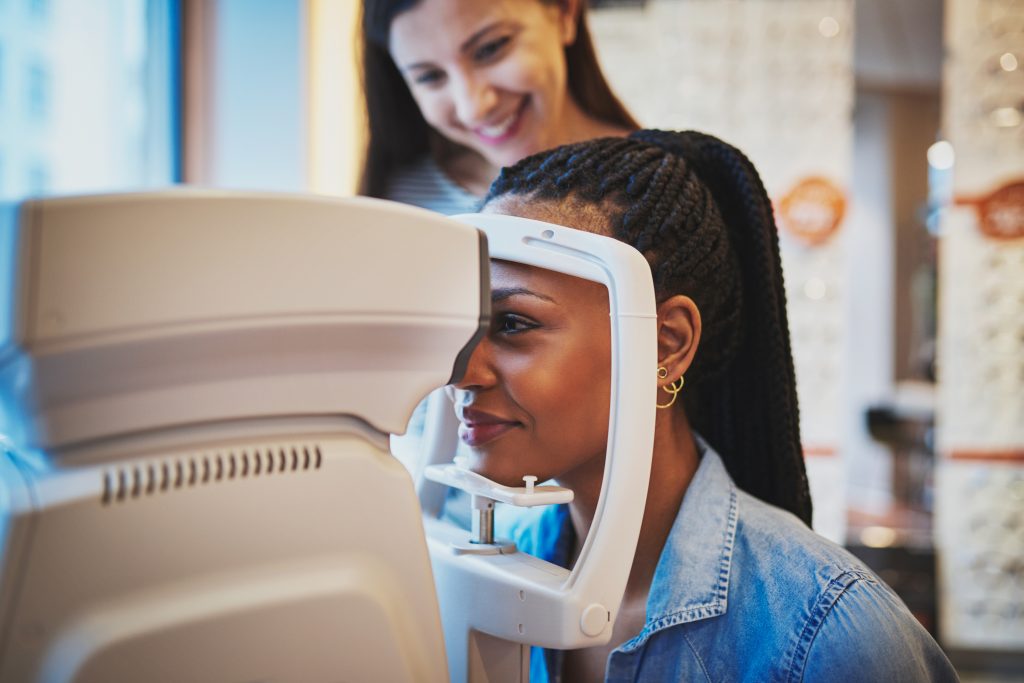What Is An Eye Exam & Why Is It Performed?

An eye exam is a series of diagnostic tests designed to assess the health of your eyes and the quality of your vision. If you are concerned that an eye exam will be painful or that the bright lights will hurt your eyes, there's no need to worry.
An eye exam is different from a simple vision screening that only determines your eyesight, like the kind administered at schools or the DMV. It includes tests to check the health of the inside and outside of your eyes. Many health conditions, like diabetes and high blood pressure, can be detected via comprehensive eye health exams.
Why Are Eye Exams Performed?
Routine eye exams detect eye health and vision problems early when they are the least damaging and most treatable. Patients at risk of certain eye conditions can be monitored, and these conditions may be prevented.
Did you know eye exams don't just tell you about the health of your eyes? They also tell you many things about your overall health. The Cleveland Clinic reports that problems or changes in the eyes can be a sign of several conditions, including autoimmune disorders, such as lupus and multiple sclerosis (MS), diabetes and diabetes-related retinopathy, high blood pressure, high cholesterol or arterial disease.
What Does An Eye Exam Check For?
Your eye doctor will look for signs of many different vision and eye health conditions that can make daily life difficult, such as:
- Nearsightedness (myopia), farsightedness (hyperopia), reduced ability to focus on close objects (presbyopia), accommodative dysfunction, low vision and other refractive errors.
- Common eye health conditions including glaucoma, macular degeneration, cataracts and retinal tears or detachment.
- Issues with the facial muscles that support the eyes, including conditions like lazy eye (amblyopia) and crossed eyes (strabismus).
- Cancer in the eye or tumors in the ocular area, including but not limited to retinoblastoma, intraocular melanoma and other forms of intraocular cancer.
What Happens During Your Eye Exam?
Don't be nervous about what will happen at the optometrist's office. Get familiar with some of the different steps of an eye exam listed below.
- Your medical history. You will be asked to give a complete health history, including any medications you are taking and what health conditions you have previously been diagnosed with by other medical professionals. If you have had glasses or contacts before, the doctor may ask for your previous prescription or can use a lensometer to determine the prescription of the glasses you currently wear.
- Eye pressure measurement. A device called a tonometer is used to check the pressure of the fluid inside your eye. There are two types of tonometry devices: one is a pen-like device that gently touches the cornea's surface after it has been numbed, and the other delivers a puff of air to the front of your eye. How your eye resists external pressure is a way of testing for glaucoma.
- Corneal thickness. Another pen-like instrument is used to check the thickness of the cornea to determine if it may be interfering with ocular pressure readings. Patients with bigger corneas will naturally have higher pressure readings, even if they do not have glaucoma.
- Visual acuity. The eye doctor will check how well you can see at various distances and if you need corrective lenses. If you do, the doctor will use a phoropter device that allows them to improve your vision with different corrective lenses until your ideal prescription is achieved.
- Pupillary reaction. Your doctor will move a bright light back and forth across your eyes to ensure that your pupils are reacting appropriately.
- Visual field testing. You may be asked to place your chin in a machine that will flash lights at various points within your visual fields to determine if you have any blind spots, which may indicate risk factors for glaucoma.
- External examination. A device called a slit lamp, or biomicroscope, will be used to check the health of the front of the eye, including the cornea, sclera, iris, eyelid and lashes.
- Ophthalmoscopy. Your pupils will be dilated using special eye drops so the doctor can use a set of magnifying lenses and a bright light to look into your eye at the back of it, where the retina and macula are. Any changes to the tissue and blood vessels here may indicate conditions like hypertension, diabetes, glaucoma and macular degeneration.
What Happens After the Exam?
Once all of the diagnostic tests have been completed, the optometrist will review the results and discuss with you any health issues you need to be aware of, vision problems in the future and what next steps are most appropriate. You can—and should—ask questions to ensure you understand everything the doctor says before leaving.
How Long Does An Eye Exam Last?
The average eye exam lasts approximately 30 minutes but may last a few hours, depending on the type of testing required and the patient's individual needs.
Schedule an Eye Exam Today
Regular eye exams are important for your vision and eye health. They can also help you detect systemic or serious health conditions like high blood pressure, certain types of tumors or cancer, and diabetes. Contact the Gulf Coast Vision Center in Pace, Milton or Crestview, or at one of our Pensacola locations at Nine Mile or East Hill to schedule a comprehensive eye exam today.
